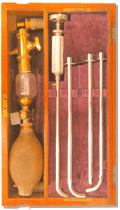


The lithotrity instruments

|
Lithotrity Case Contains a lithotrite and a Thompson's evacuating apparatus: Steel, brass, glass and rubber; 19th century; S. Maw, Son & Thompson, London |
The initial speech of the student José Ignácio Martins Lavado, from the Medical and Surgical School of Lisbon, "Considerações sobre as vantagens e inconvenientes da aplicação da talha e da Lithotricia" ("Considerations on the advantages and disadvantages of the use of the lithotomy and of the Lithotrity") (1868), presents the methods of lithotomy and lithotrity in the cure of vesical lithiasis, the morbidity and mortality associated to it and the international and national statistical studies available at the time. In Portugal there was a clear preference for the use of the lateral lithotomy surgery, according to Fr. Cosme (1748). The hidden litho tome, modified by Charrière, was used. However, in the Medical School of Lisbon certain lateral lithotomy surgeries were performed, according to Hawkins, by Joaquim José Pereira, Ribeiro Viana and Joaquim Theotónio da Silva. António de Almeida claims to have practised in nineteen such surgeries using this method, in 1800, in London, without complications. In the lithotrity the Portuguese surgeons preferred the Hourteloup instrument modified by Charrière.
According to this speech the genital and urinary accidents (pain, cystitis, prostatitis, vesical laceration, fraction of the lithotrity instrument in the vesicle, stone getting stuck) were more frequent with lithotrity than with lithotomy although, with the latter, there were more unrelated complications (bleeding, rectum peritoneum lacerations, phlebitis, peritonitis and sinus tract formation).
In Portugal lithotomy was more frequently used than lithotrity.
However, in his opening thesis "Breves considerações sobre a Lithotricia: Methodo de Bigelow" ("Breve considerations about lithotrity: Bigelow's Method") presented to the Medical and Surgical School of Lisbon, António Candido Neves defended the advantages of lithotrity using this method over the former. With this method artificial suctioning followed stone fragmenting. Cornay de Rochefort introduced the lytic suctioning using a truncated catheter (1843); Sir Philip Crampton invented a sucker (1846) that was later improved by Clover, of London. It was to Bigelow to create a new sucker with a bore gauge catheter with good clinical results. António Maria Barbosa and Curry Cabral from the School of Lisbon successfully practised lithotrity according to Bigelow's method.